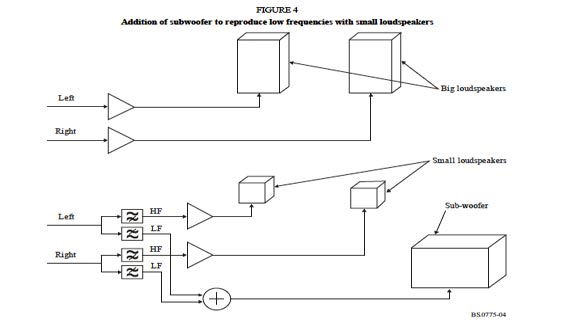LFE: Putting The Low End To Work
The final section of the ITU specification is an Appendix to Annex 7, which we explored a few posts back. The Appendix addresses the practical application of the LFE channel and the differences between a subwoofer and the .1 channel. Remember that the LFE (Low Frequency Effects or Enhancement channel is not required and should not be considered essential to enjoying both movies and music in surround.
The purpose of the LFE channel is to provide high-level sound reproduction of low frequency “effects”. It is typically associated with compressed digital systems including AC-3 or Dolby Digital or Dolby E systems. There is often confusion regarding the difference between the .1 channel in a surround system and the amplified speaker used to deliver low frequencies.
A subwoofer is a dedicated loudspeaker used to extend the lower frequencies of a playback system that would otherwise not be reproduced by the normal woofers found in typical speakers. The use of a single (or sometimes a pair) subwoofer in a multichannel playback system is common because low frequencies are far less directional than high frequencies. The practical limits of a subwoofer are 16 – 120 Hz.
Commercial multichannel systems for home theaters and automobiles are often designed around small “satellite” speakers that are unable to reproduced extreme bass. Everyone is probably familiar with the success that Dr. Bose and the Bose Company have had with this configuration.
The LFE channel is usually thought of as the .1 channel in a Dolby Digital (AC-3) audio stream. The “purpose of the Dolby AC-3 low-frequency effect channel, the (LFE, or ‘0.1’), is to provide a channel for loud sound effects that would be too loud for normal channels specific to movies. Audiophiles are not generally listening to Dolby Digital compressed and “lossy” files. Live concert DVDs use Dolby Digital but I don’t consider concert sound to be audiophile quality.
There are two characteristics that make the LFE channel ideal for low frequency movies effects. First, it is limited to 120 Hz and lower and upon playback an additional 10 dB of gain is applied.
The subwoofer speaker in a multichannel playback system can be used to extend the frequency response beyond the limitations of the main speakers. Subwoofer cabinets contain speakers that are larger…sometime much larger than the 10-12 inch drivers found in traditional cabinets. The TMH Labs “Profunder” subwoofer in my mixing room is a passive cabinet with a 15″ driver in it.
If having extreme low-end response is important in your rig, then you might consider adding a subwoofer speaker (and amplifier) by having the left and right outputs from your preamplifier routed to a matched set of filters. The high frequency components are sent to the main speakers, which can be smaller than usual, and the low frequencies are summed and sent to the subwoofer speaker.
This is a simple “bass managed” system. The redirecting of the low frequency signal components to a speaker channel specifically designed to extend the low end of your system is often an inexpensive additional to a stereo or multichannel system.


I had a nice early Sony surround receiver that didn’t have a dedicated sub out. It did have a complete set of line outs for all the channels so I used a splitter and combined the main channel and fed it to a passive Radio Shack sub I got dirt cheap. I had a extra amp and used it from the combined output to drive the sub.
All I did was adjust the line in gain till it disappeared into the mains except for a lot of clean deep bass no matter what I was listening to.
My main speakers I built myself and had 8″ Gefco woofers that really worked well but didn’t hit that lowest octave.
Used that setup for years till I got a good deal on a 12″ true powered sub that I’m still using with my latest receiver with a dedicated sub out.
I still use my home built speakers, the sub’s added the super low bass they were missing.
Fun part us getting everything dialed in so it blends and sounds the way I want.
I’m a little confused. Should I use LFE, or should I use the center channel speaker out? I have an older Yahama receiver. My main front speakers roll off below 50 hz. My rears go down to about 40 hz. Currently, I use the LFE, thinking it was one the same as the speaker outputs except that it relieved the receiver from driving the sub. Should I hook up my sub from the subwoofer speaker outputs of the receiver instead? Would this tax the receiver more? It already has enough of a load since my main speakers are small Maggies. I am more concerned with bass quality for 5.1 music than I am for deep bass or movie effects. Please reply if you time – Thanks!
You should use the LFE output to your subwoofer speaker. It will not tax the AVR.
I assume you mean he should use the subwoofer output – I’ve never seen a separate “LFE” output on an AVR.
The label on the back of the device would be subwoofer. But, as we’ve seen, the signal output is actually the LFE channel.